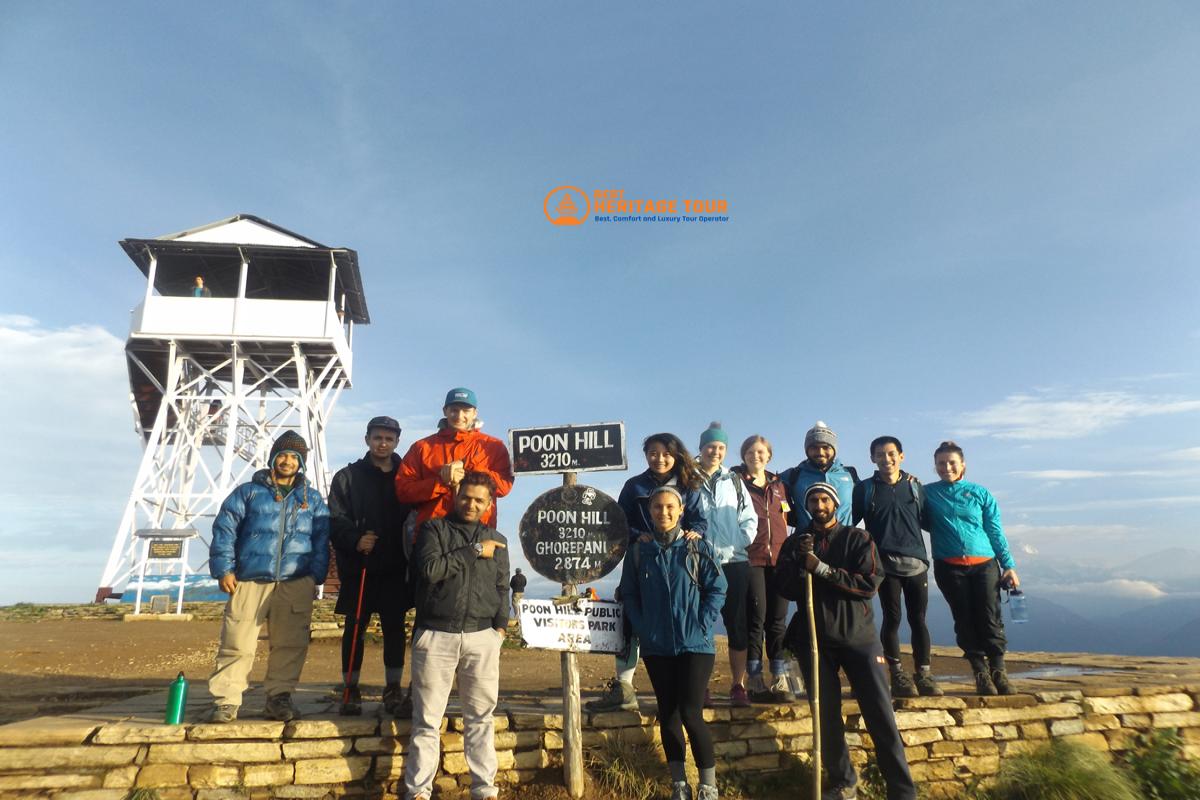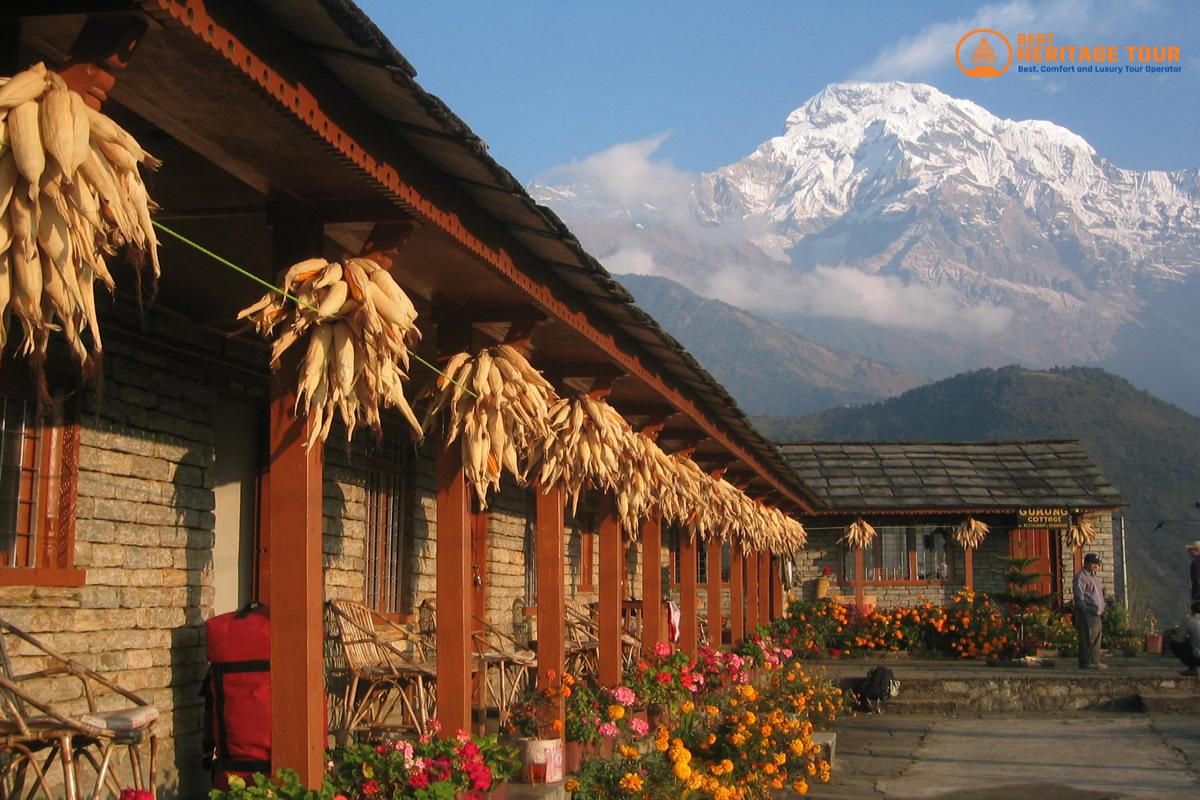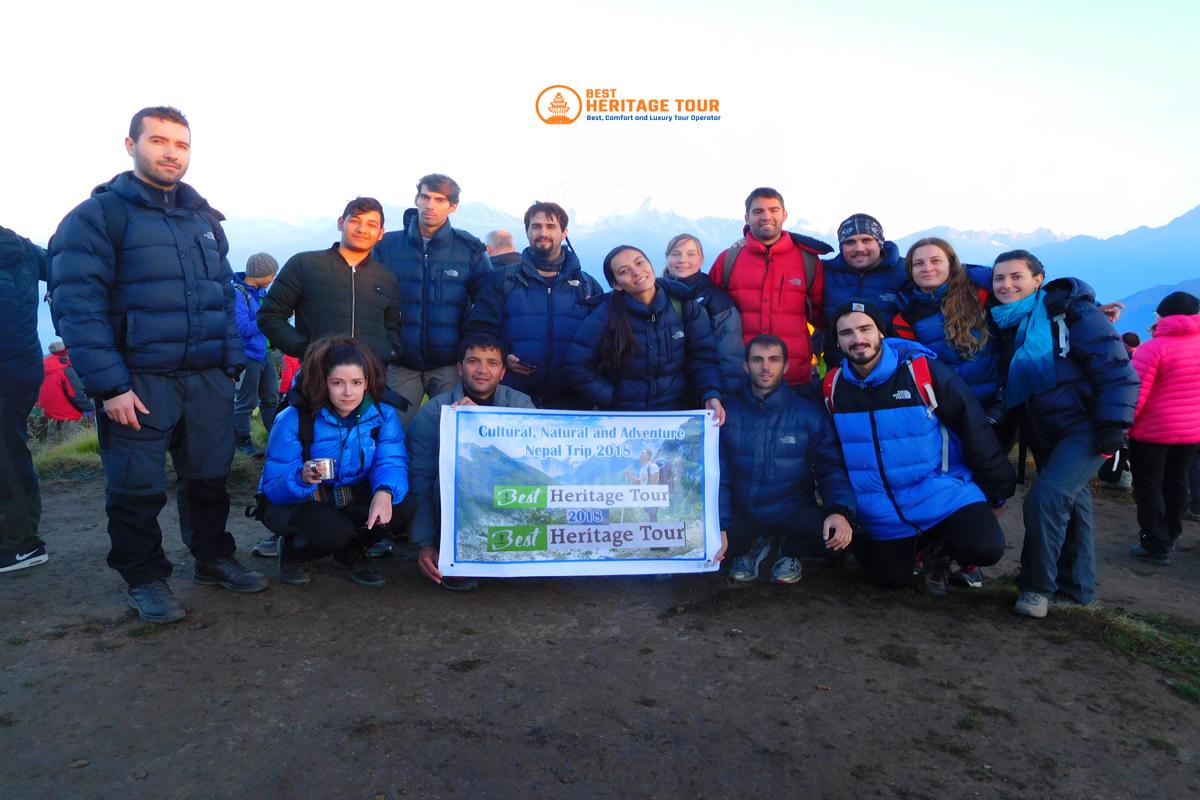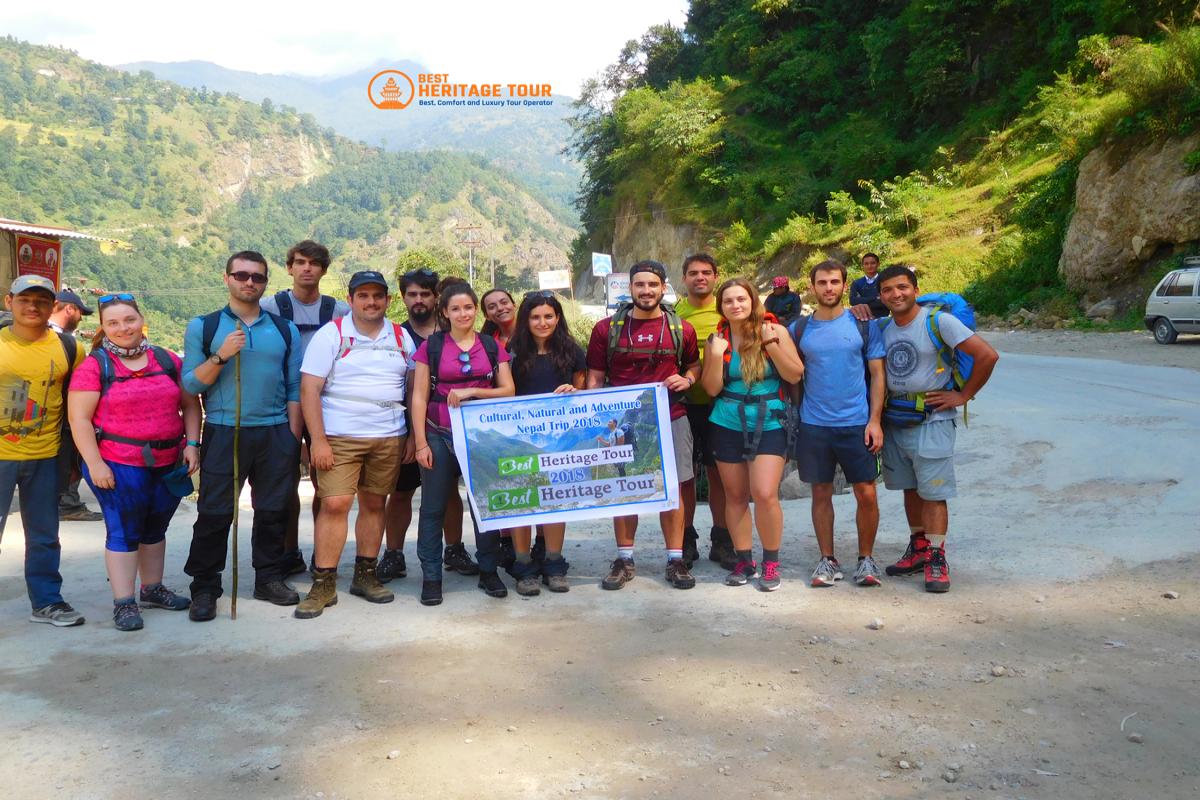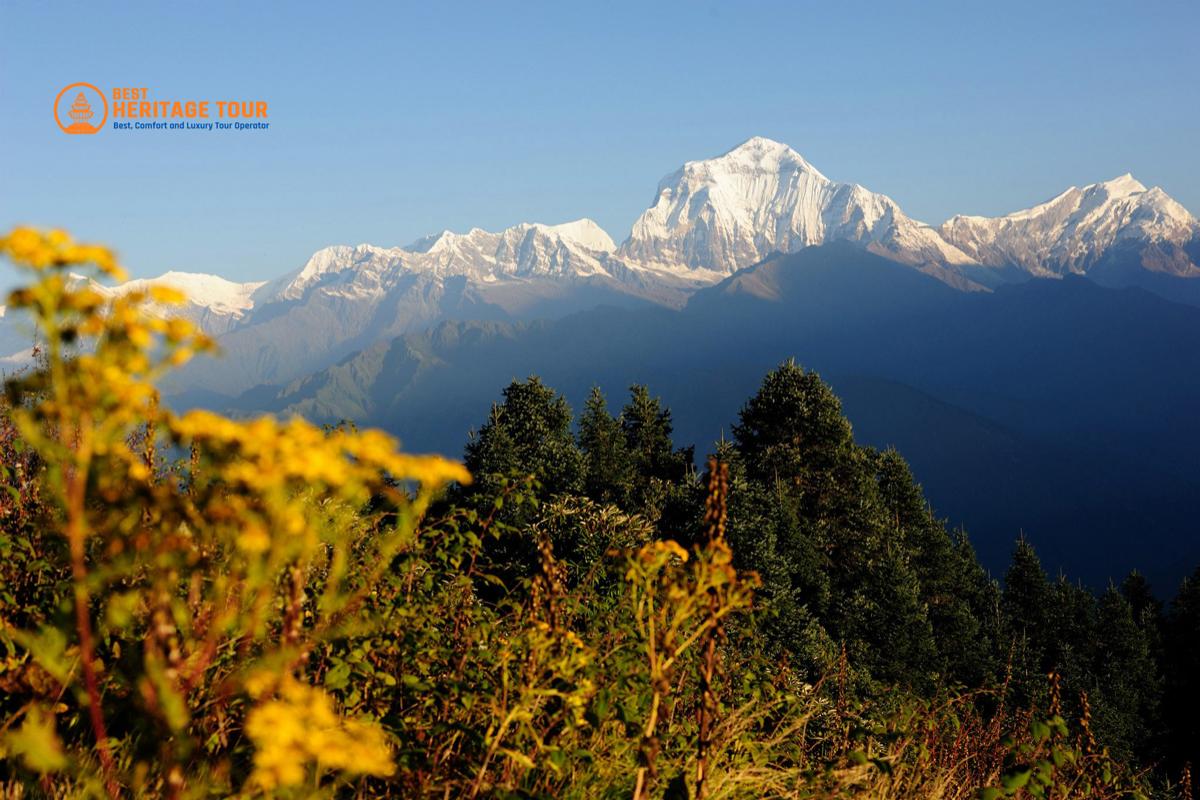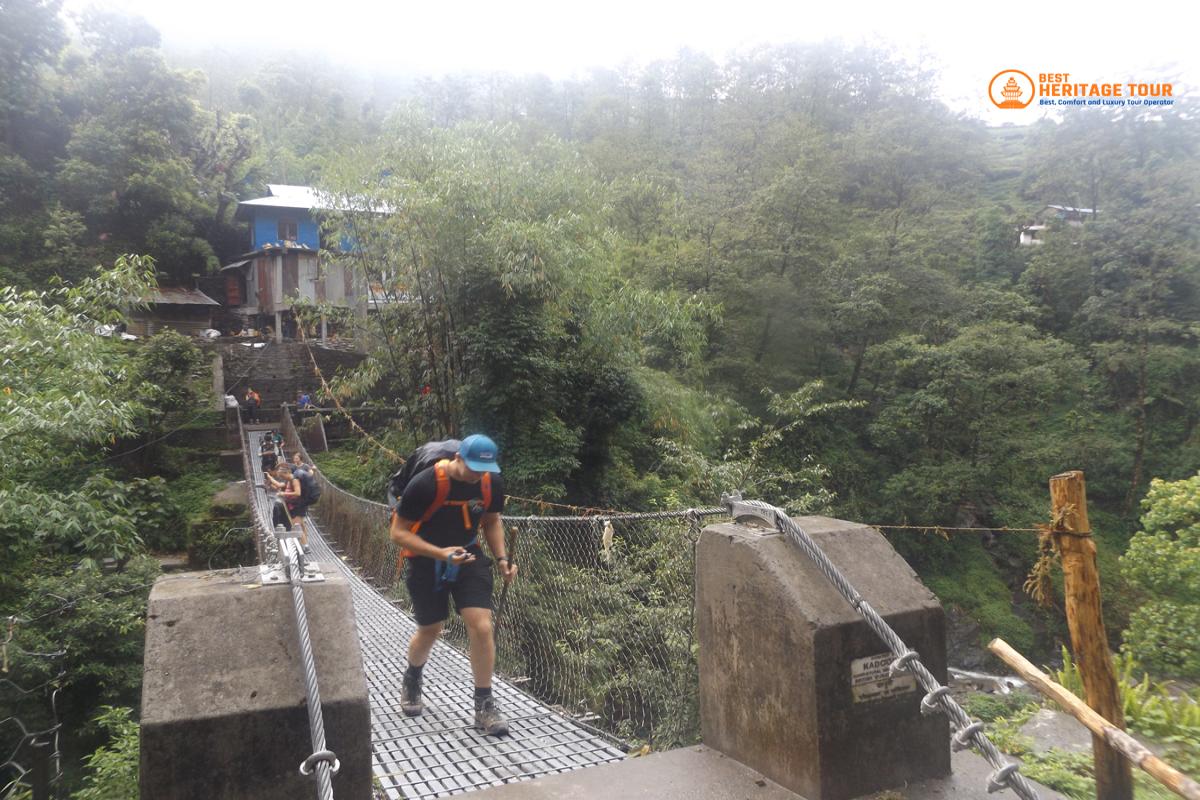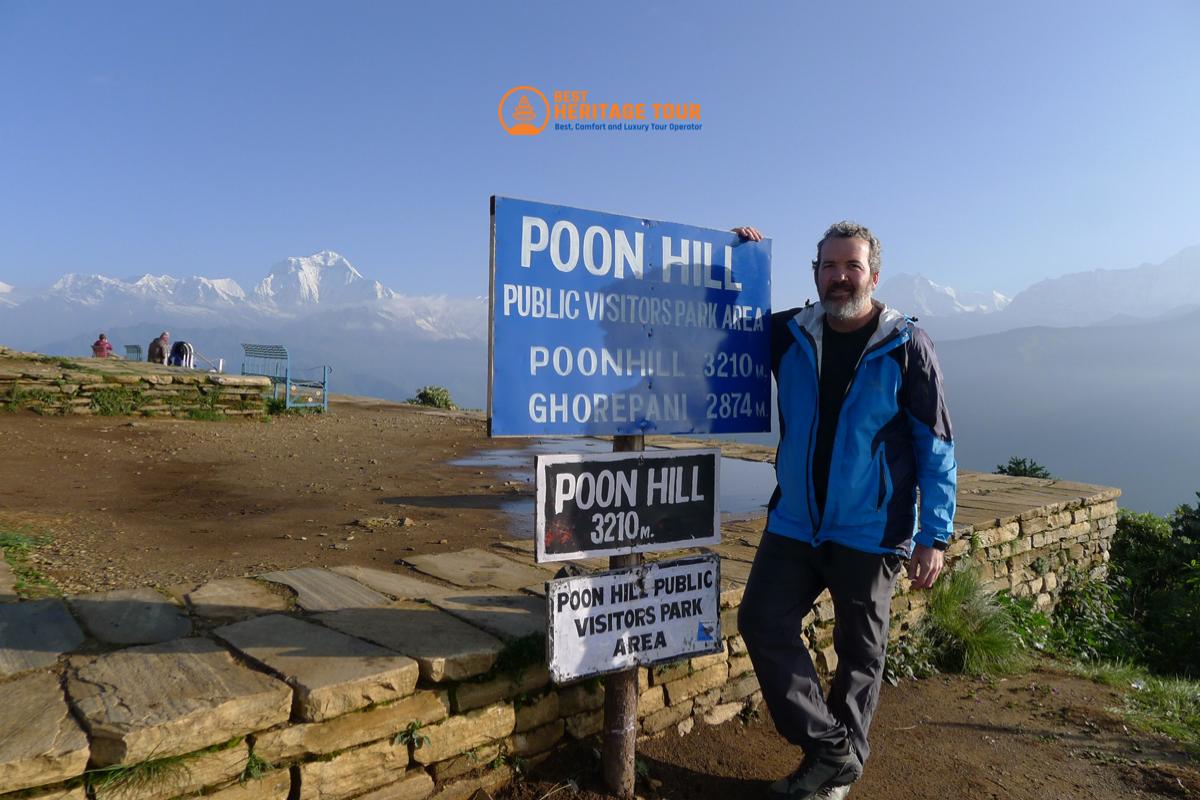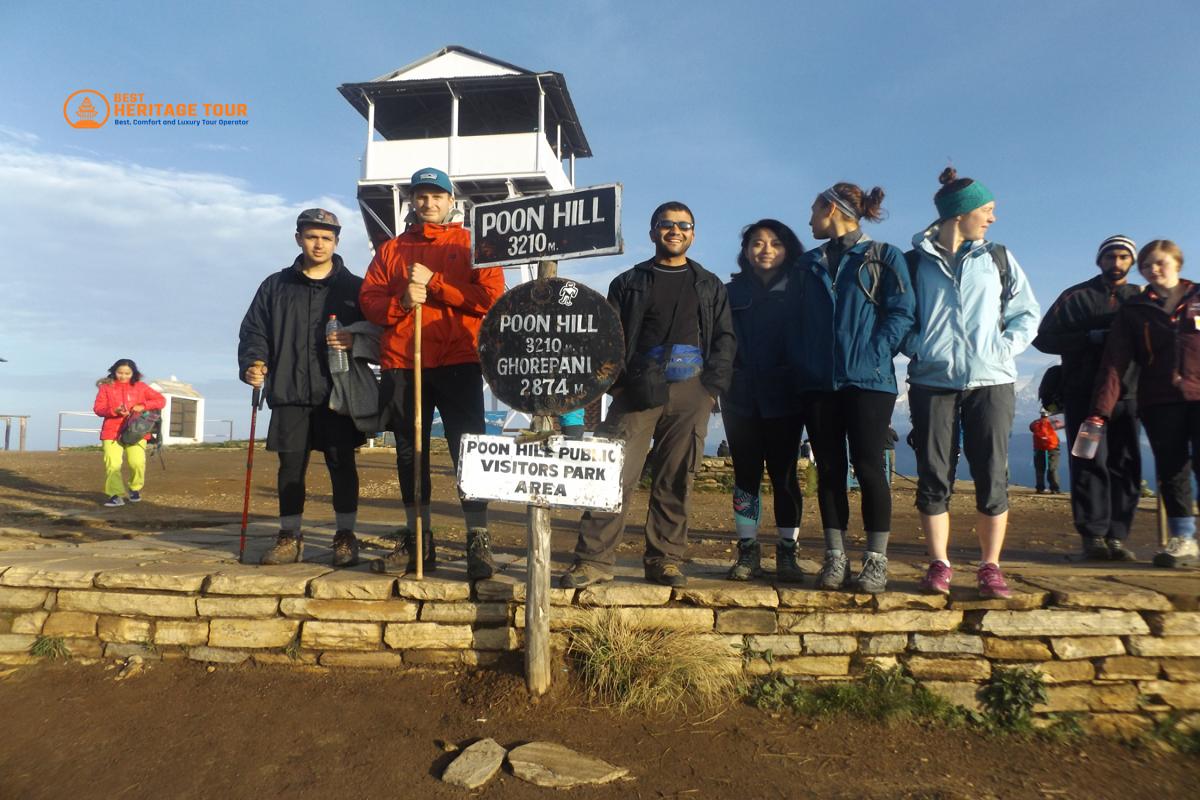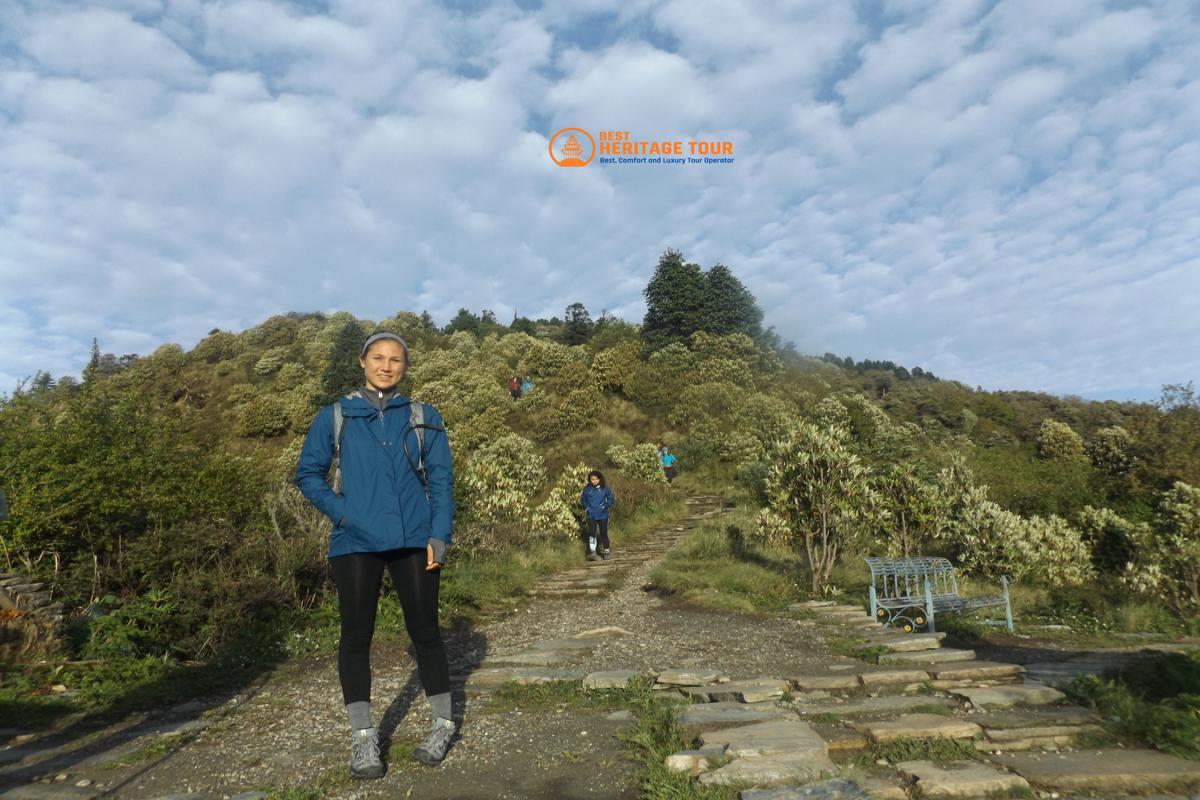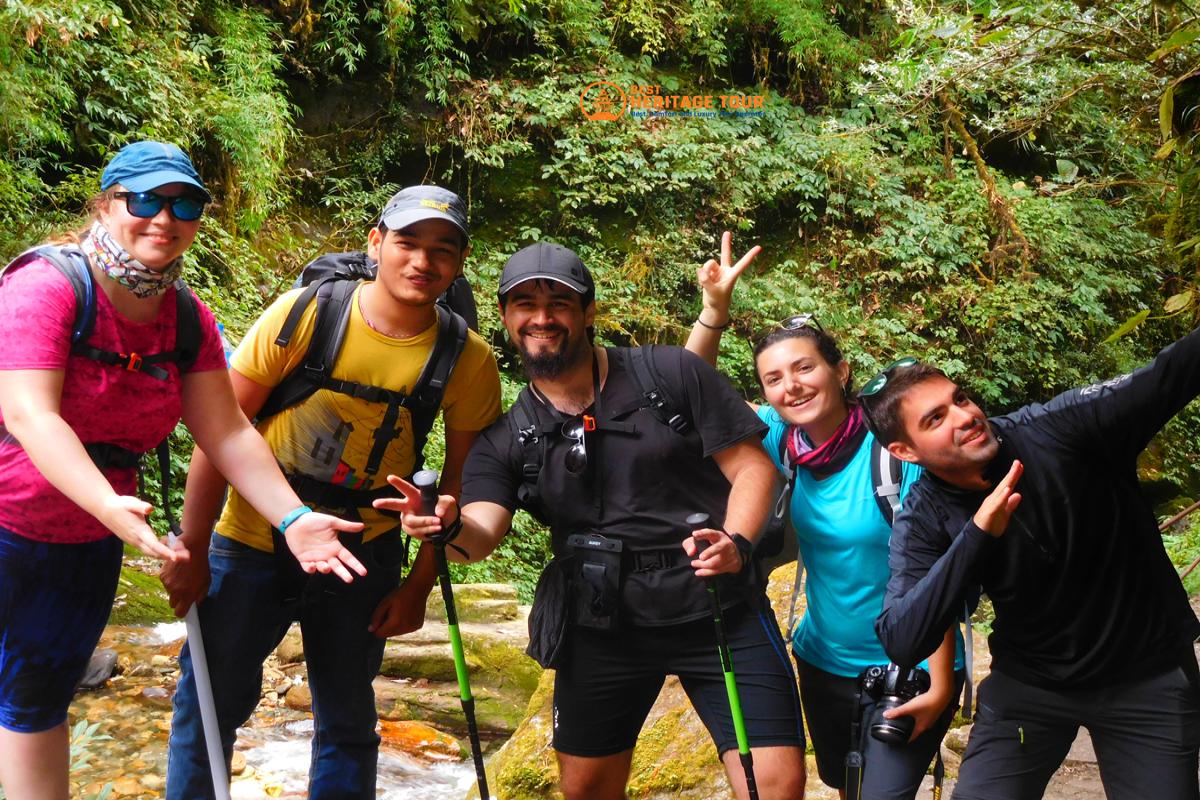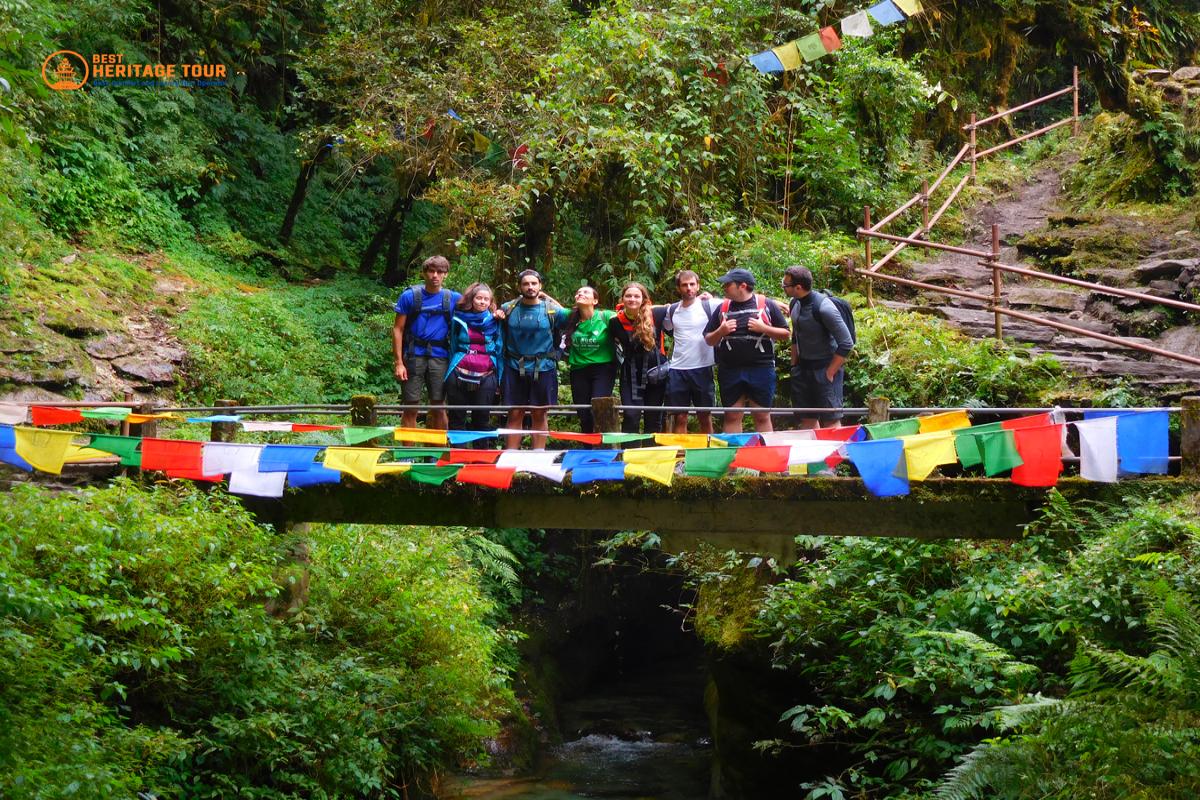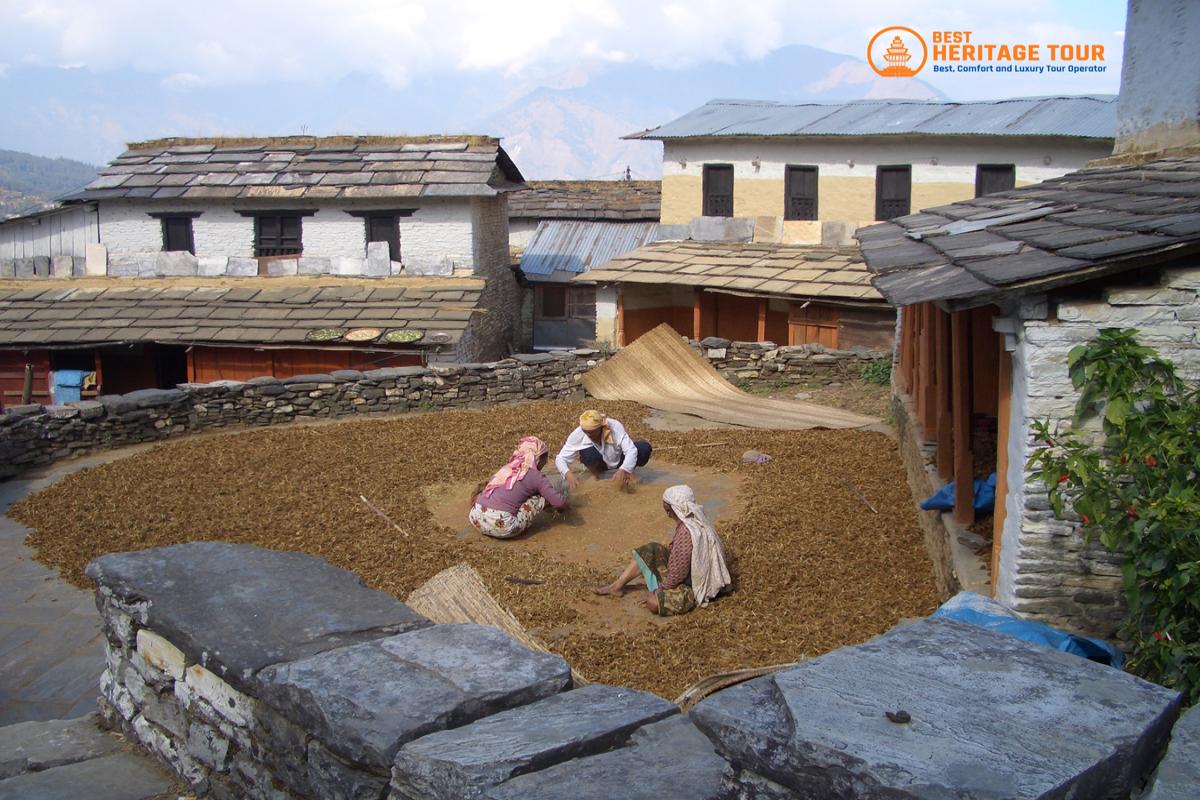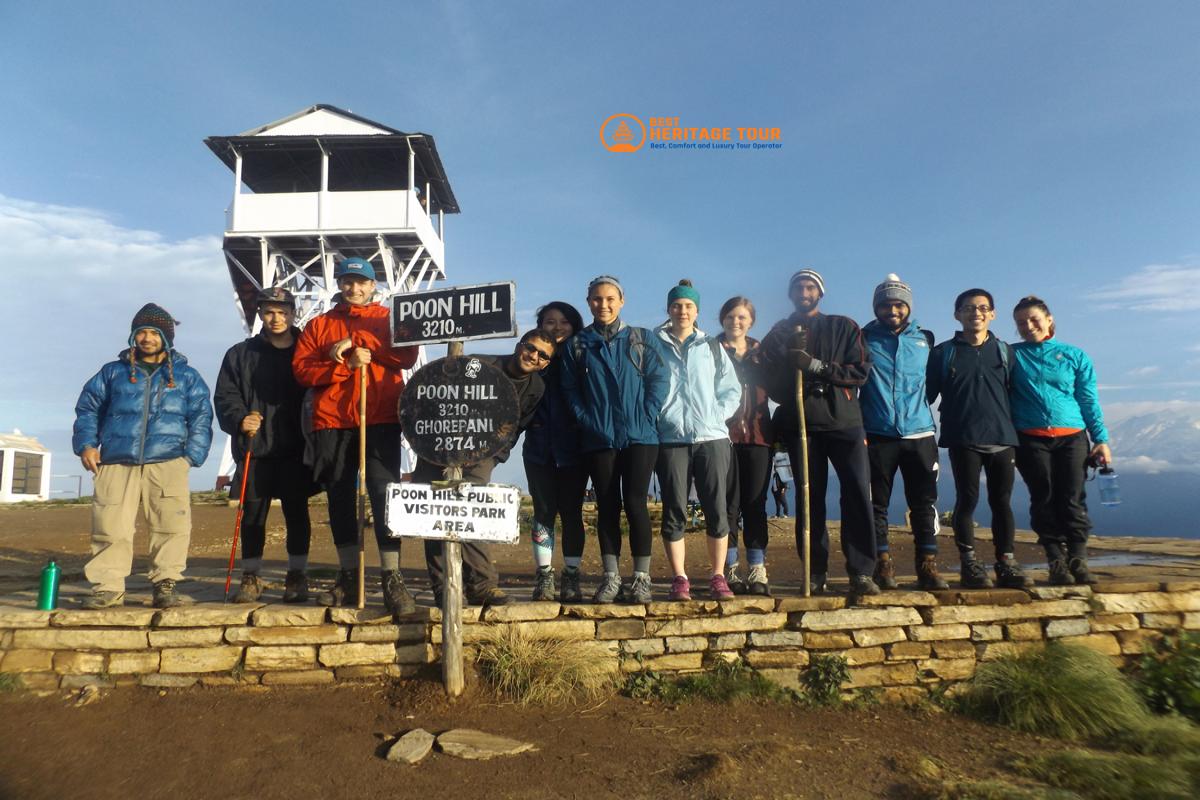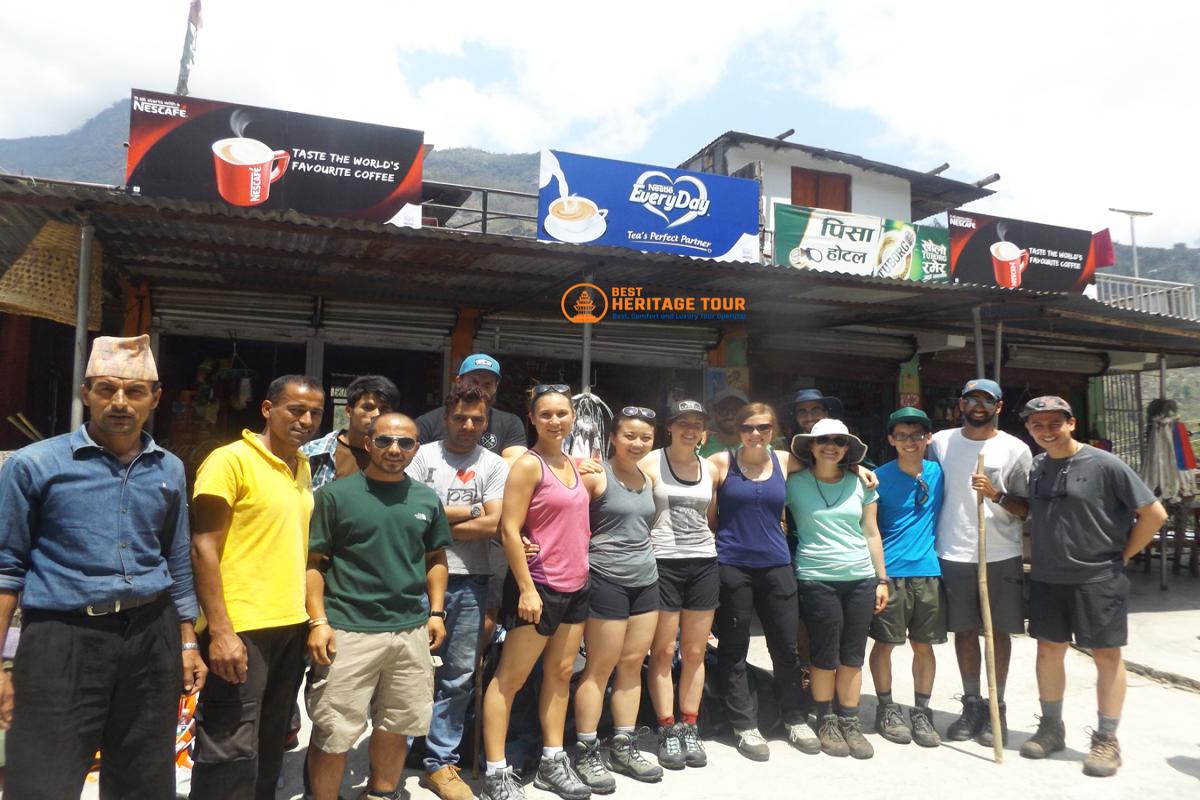Ghorepani Poonhill Short Trek - 4 Days
Insight on Ghorepani Poonhill Short Trek
Explore the Ghorepani Poon Hill Trek, a top choice for a quick adventure in Nepal. Traverse through vibrant forests, charming villages like Ghorepani, and reach Poon Hill for breathtaking views of the Annapurna ranges, Dhaulagiri, and Nilgiri mountains.
Trip at a Glance
Key Features of Poon Hill Hike
- Pokhara - the premier tourist destination in Nepal
- Breathtaking mountain vistas from Poon Hill (3210m) Observation Deck
- Ghorepani village
- Relaxing hot springs at Jhinu Danda
- Brief trek ideal for all demographics
- Hassle-free trek with no worries about altitude sickness or acute mountain sickness
- Charming villages and agricultural land at Ghandrung
- Experience authentic Nepali rural lifestyle
Advantages of Ghorepani Poon Hill Trek with Best Heritage Tour
- Convenient booking and reservation process
- Comprehensive online trip briefing post booking confirmation
- Various communication channels (Email, WhatsApp, Facebook, WeChat, Viber, Skype, Zoom)
- Round-the-clock phone support at +977- 9851149197
- User-friendly payment options
- Oximeter provided for blood oxygen monitoring at high altitudes to detect altitude sickness early & other medical kits
- Complimentary sleeping bags and down jackets if needed
- Duffle bag provided for porters
- Complimentary excess luggage storage at the Best Heritage Tour store during the trek
Online Trip Briefing
The online briefing will provide comprehensive information regarding the trek, such as the required equipment checklist, detailed itinerary, and trail expectations. Upon booking completion, we will promptly email you the trek briefing schedule options. Once we have received your necessary documents, the online trek briefing will be scheduled.
Experience the Ghorepani Poon Hill Trek with a Comprehensive View
Once in Pokhara, the adventure begins with a scenic drive to Ulleri via Tikhedhunga.
As you make your way to Ghorepani, take the opportunity to immerse yourself in the local culture by interacting with villagers and exploring the charming villages along the route. The trek offers breathtaking views of the Annapurna range, Machhapuchhare, Hiunchuli, and the majestic Dhaulagiri.
The highlight of the trek awaits you at Poon Hill, where you can witness the spectacular sunrise over the snow-capped Himalayas. Capture the beauty of glaciers and towering peaks such as Annapurna I, Dhaulagiri, and Machhapuchhare from this vantage point, a favorite spot for photographers.
Continue your journey to Tadapani through enchanting rhododendron forests, and marvel at the grandeur of the Annapurna mountains from this picturesque village. Trek to Jhinu Danda on the third day, passing through bamboo, oak tree forests, and the tranquil settlement of Chomrong. Relax and rejuvenate in the natural hot springs near Jhinu Danda.
On the final day of the trek, trek from Jhinu Danda to Siwa / Ghandruk Phedi, soaking in the beauty of the countryside along the way. Conclude your adventure with a return journey to Pokhara, reminiscing about the unforgettable experiences and stunning views of the Ghorepani Poon Hill Trek.
Itinerary
Following breakfast, we will drive to Birethati, a journey that will take 2 hours. Birethati serves as the entry point for both the Poon Hill Trek and Annapurna Base Camp. Our Ghorepani Poon Hill Trek will lead us through authentic villages, lush rice fields, flowing rivers, and rolling hills. Along the way, we will pass by local villages such as Birethati, Sonari, Hill, Tikhedhunga, and Ulleri. The ascent from Birethati to Ulleri involves climbing 900m. Furthermore, after Tikhedhunga village, the trail continues to steadily climb towards Ulleri. Ulleri village stands out as one of the largest Magar settlements and is considered one of the most picturesque villages along the trek. The views from Ulleri are truly breathtaking, and we will spend the night at a lovely local guest house.
Commencing the day with a rigorous uphill trek on stone steps for over an hour to reach the peak of Ulleri village, a quaint settlement with traditional Nepalese architecture featuring slated roofs. The journey continues with a gradual ascent through captivating rhododendron and pine forests, culminating in the arrival at Ghorepani village, perched on a ridge enveloped by stunning rhododendron trees. This village is predominantly inhabited by the Poon people of the Magar tribe and is renowned for the panoramic Poon Hill viewpoint, accessible after an hour's climb.
Embark on an early morning ascent to Poon Hill to witness the breathtaking sunrise over a multitude of Himalayan peaks, including the 7th highest Dhaulagiri and the 10th highest Annapurna. Take in the panoramic views of the world's 8th highest peak, Manaslu, and the iconic Machhapuchare peak "Fish Tail". After savoring these unforgettable moments, return to Ghorepani and continue your trek through the lush forest terrain, eventually arriving at Tadapani for an overnight stay.
Departing from Tadapani village, we head towards the popular Ghandruk village. The trail is straightforward and leads us to Ghandruk via Bhaisikharka, passing through a charming village. Ghandruk village offers breathtaking views of various mountains and landscapes, making it a must-visit destination. Here, you can immerse yourself in the local culture, visit the Gurung Museum, and experience an authentic Gurung village. After a quick lunch, we will descend 5 minutes to Ghandruk Danda, where you can catch a local or private vehicle to drive to Pokhara. The journey to Pokhara will take a maximum of 4 hours, passing through Syauli Bazaar, Birethati Nayapul, and finally reaching Pokhara.
What is included?
- Meals During Trek: Standard meals provided in the mountains (Breakfast, Lunch, and Dinner) throughout the trek.
- Trekking permit: Comprehensive package with 'Trekkers' Information Management System (TIMS) and ACAP Permit included.
- Exclusive private vehicle transportation provided from Pokhara to Nayapul and Nayapul to Pokhara.
- Accommodation arrangements during the trek.
- Provision of fresh fruit during the trek.
- An experienced, expert guide who is friendly and helpful, with all expenses covered including salary, food, drinks, accommodation, transportation, and insurance.
- Emergency Helicopter service arrangement costs covered by your Travel insurance company.
- Medical kit provided for emergencies.
What is not included?
- Nepal entry visa fee (visa can be obtained upon arrival at Tribhuwan International Airport - Kathmandu).
- Travel and rescue insurance.
- Personal porter.
- Bar bills and personal expenses (phone calls, laundry service, battery recharge, bottled water, hot water, shower).
- Tips for trekking crews.
- All government taxes 13%, SSF, and 10% service charges
Route Map
Review
Great trek in Annapurna Conservation Area
Amazing 6 days trek with our guide, Madhu Dhamala, who, in addition to a perfect knowledge of the mountain environment, showed remarkable patience and kindness with our 5-year-old...
View DetailA Must-Do Trek in Nepal
The trek to Ghorepani Poonhill with Best Heritage Tour was an amazing experience. It involved visiting beautiful villages while enjoying beautiful views of the mountains. The team...
View DetailPerfectly planned trek for me
Best Heritage Tour did a fantastic job personalizing trek to adjust my schedule. Milan was knowledgeable, excellent, friendly guide, and the trek was outstanding! Highly...
View DetailShort and Beautiful Trek!
I recently done my Ghorepani Poonhill 4 Day Trek successfully with Best Heritage Tour. This trek was not too hard and I saw many beautiful places. The guide Milan Buda tell us many...
View DetailHighly recommended family trek
For our family, this was a great trekking experience. I was travelling with my daughters and was a bit worried since this was our first trek. The guide, Madhav, was really great,...
View Detailunforgettable trek in the Himalayas
I recently completed my 4 day Ghorepani Poonhill trek with the Best Heritage Tour, and it was unforgettable trek of my life. I will never forget how the sunrise at poonhill glows...
View DetailNice Trekking, Good Service!
I liked this trek very much! The Mountain View was amazing. We wake up early to go Poonhill and the sunrise was so beautiful. Best heritage tour arranged everything well and we did...
View DetailAn Unforgettable Short Trek in Nepal
We booked Ghorepani Poonhill Trek with Best Heritage Tour, and the experience was simply wonderful. The trek was well-organized, and our guide, Milan, made it easy for us to have a...
View DetailFAQ's
Yes, all our guides are fluent in English and many speak other languages. This facilitates clear communication and enhances your overall experience.
Most trekking guides in Nepal speak basic to advanced English, which is enough for general communication about trekking and safety precautions. Some speak more fluent English, which will improve your overall trekking experience.
Yes, most visitors need a tourist visa to enter Nepal. A visa can be obtained on arrival at Tribhuvan International Airport in Kathmandu or applied for in advance at a Nepalese embassy or consulate.
Yes, you will need two passport-sized photos for both the visa application and the trekking permits, so it's a good idea to bring extra copies just in case.
You'll need a valid passport (with at least six months validity), a passport-sized photo, and the visa fee (which varies depending on the duration of stay).
To obtain the RAP, you’ll need:
- A valid passport.
- A Nepal visa.
- Travel insurance.
- Two passport-sized photos.
- A letter from your trekking agency detailing your itinerary and the names of the guide and group.
Yes, it’s possible to extend your visa if you wish to stay longer in Nepal. Extensions can be processed at the Department of Immigration in Kathmandu or Pokhara, but you should apply before your current visa expires.
You can exchange US dollars or Euros for Nepalese rupees upon arrival, but we recommend carrying cash in the local currency for most transactions outside of major cities.
To ensure you are comfortable while trekking, your backpack should ideally weigh 10-15% of your body weight, usually around 10-15 kg (22-33 lbs).
Physical preparation is essential to a successful trekking experience. Begin an exercise program 6-8 weeks before your hike that focuses on:
- Aerobic exercise: Activities such as running, cycling, and swimming to improve endurance.
- Strength training: Leg, core, and upper body exercises to increase strength.
- Practice hiking: Fill up your backpack and go on a short hike to simulate trekking conditions.
It is important to stay hydrated while climbing. Bring a reusable water bottle and use water purification tablets or a filter if necessary. Pack energy-rich snacks such as nuts, energy bars and dried fruit to maintain your energy levels throughout the day.
Before any hike, test your equipment on a training hike to make sure everything fits well and works properly. Ensure that you break in your trekking footwear to prevent blisters and discomfort.
Yes, we recommend that you have a small first aid kit with some basic items such as adhesive tape, disinfectant wipes, painkillers, altitude sickness medication, and personal medications.
Yes, you can rent trekking gear in Kathmandu and other major cities. However, we recommend that you check the quality and suitability of the equipment before renting.
Pay attention to your body's signals, especially when fatigue sets in.
- Take a break: Take a break when necessary and find a comfortable place to sit and relax.
- Stay hydrated: Drink water regularly and eat snacks to replenish your energy.
- Inform your tour guide: Should you begin to feel unwell, it is important to communicate this to your tour guide. They can assist in modifying the pace and itinerary as needed.
Training at altitude helps your body adapt to lower oxygen levels, which can be beneficial for hiking. However, it is not absolutely necessary. Being in good cardiovascular condition can also prepare you for the conditions.
Consult your doctor for individual vaccination recommendations. Common vaccinations climbers should consider include:
- Tetanus
- Hepatitis A and B
- Typhoid
- Rabies (if in contact with wild animals)
The main health risks while trekking include:
- Altitude sickness: occurs when you ascend too quickly without adequate acclimatization, causing symptoms like headaches, nausea, and fatigue.
- Dehydration: Insufficient fluid intake can cause fatigue and headaches.
- Injuries: Falls and slips on uneven surfaces can cause sprains and fractures.
Trekkers are strongly encouraged to take out travel insurance. Make sure your insurance covers high altitude hiking, medical evacuation and trip cancellation. This gives you peace of mind and financial protection in case of emergencies or unexpected events.
In case of emergency:
- Keep calm: Staying calm helps you make better choices.
- Contact your tour guides. They are trained to deal with emergencies and know what is best.
- Use communication devices: If necessary, you can use satellite phones and emergency transmitters for communication in remote areas.
In remote and secluded areas, maintaining a sense of connection can prove to be quite challenging.
- Cellular Network: Most areas along the trek have good mobile coverage, especially in larger villages such as Samagaon. However, signals can be unreliable.
- Wi-Fi Availability: Some teahouses offer Wi-Fi, but the connection can be slow and there may be a charge.
- Satellite Phone: If traveling to an area without cell coverage, consider renting a satellite phone in case of emergency.
Yes, Nepal offers an electronic visa (e-visa) that can be applied for online before arriving. This process enables you to bypass the visa queue upon arrival at the airport. After completing the online application, you can get your visa stamped on arrival.
The tourist visa fees are as follows:
• 15 days: USD 30
• 30 days: USD 50
• 90 days: USD 125 Note that these fees are subject to change, so check the current visa fees before your trip.
No, previous trekking experience is not mandatory. However, a good level of physical fitness is necessary, as the trek involves walking for 5-7 hours per day and ascending to high altitudes.
Most teahouses in remote areas do not allow online reservations. However, during peak seasons, guides or trekking agencies can help secure rooms in advance. It’s recommended to have a guide manage accommodations, especially in crowded seasons.
Yes, teahouses usually provide blankets, but they may not always be warm enough at high altitudes. Bringing your own sleeping bag rated for cold weather is essential.
Yes, it's recommended to bring your own trekking poles. They provide essential support during steep ascents and descents, and are particularly helpful for managing balance on rough terrain.
You should bring sturdy, waterproof trekking boots with good ankle support. Ensure they are well broken-in before the trek to avoid blisters or discomfort.
Start a fitness routine several months before the trek to gradually build strength and endurance. Even light to moderate exercise a few times a week can help condition your body. You can also opt for shorter and easier treks first to gain experience.
Yes, waterborne diseases are a concern in remote areas. Always drink purified or boiled water. Bring water purification tablets or a portable water filter to treat water from local sources.
Yes, if you wish to extend your stay, you can apply for a visa extension at the immigration office in Kathmandu or Pokhara.
While Nepali is the primary language, most staff members in lodges speak English, and some may even speak other languages. Communication should not be an issue for international tourists.
It’s advisable to be up-to-date on routine vaccinations, including hepatitis A and typhoid. Talk to your doctor about the vaccinations you need for Nepal.
- Cardio: Running, swimming, or cycling 3-4 times a week can improve endurance.
- Leg Strength: Include exercises like squats, lunges, and hiking on hilly terrain to prepare your legs for the varied elevation gains.
- Endurance: Long walks with a backpack, gradually increasing your distance and weight, will help your body adjust to carrying a load for extended periods.
Choosing the best heritage tour provides an enriching cultural experience, blending education, comfort, and unique local interactions for unforgettable travel memories.
The majority of international flights arrive at Tribhuvan International Airport, which is located in Kathmandu. From this location, travelers can connect to Lukla to commence their trekking journey.
You typically need a valid passport, a completed visa application form, and a passport-sized photo. Payment can be made in cash or via card at the airport.
Yes, tourist visas are eligible for extension at the Department of Immigration located in Kathmandu. Ensure you have a valid reason and required documents for the extension.
The Ghorepani Poon Hill Trek is a short, moderate trek in the Annapurna region of Nepal. It takes you through beautiful forests, charming villages, and up to Poon Hill (3,210 meters) for a panoramic sunrise view of the Himalayan mountains.
The trek typically takes 4-5 days, depending on your pace and starting point.
- Autumn (September to November):Clear skies, stable weather, and beautiful views make this the most popular time.
- Spring (March to May):The weather is warm, and rhododendron forests are in full bloom.
- Monsoon (June to August):Not recommended due to heavy rain, leeches, and cloud-obscured views.
- Annapurna Conservation Area Permit (ACAP): Essential requirement for trekking in the Annapurna region.
- Trekkers’ Information Management System (TIMS) Card:Required for safety and tracking of trekkers.
Teahouses (basic lodges) are available along the route. They offer simple rooms, typically with shared bathrooms. The teahouses offer a variety of meals, blending together local flavors with international dishes.
- Clothing: Layered clothing (base layer, insulating layer, waterproof outer layer), warm hat, gloves, trekking socks, and comfortable trekking shoes.
- Gear: Trekking poles, headlamp, water bottles, purification tablets, sleeping bag (can be rented), and basic first aid kit.
- Documents: Passport, permits, and some cash (ATMs are not available on the trek).
While the trek is well-marked and can be done independently, many trekkers hire a guide for safety, local knowledge, and cultural insights. A porter is available to assist with the transportation of your heavy luggage, ensuring a smoother journey.
The altitude on this trek is relatively low compared to other treks in Nepal, so the risk of altitude sickness is minimal. However, it’s still important to stay hydrated, go at a steady pace, and be aware of symptoms.
If you wish to extend your stay in Nepal beyond your visa’s initial duration, you can do so by applying at the Department of Immigration in Kathmandu. Extensions are available for a maximum of 30 days, and it’s recommended to apply before your current visa expires. Best Heritage Tour can help you with the extension process if required during your Australian Camp Trek.

